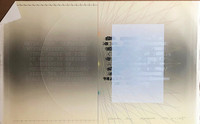
An Educated Collector is Our Best Client
In business for nearly two decades, we are a well established, popular contemporary art boutique specializing in expertly chosen, blue chip prints, multiples, uniques, books, ephemera and merchandise at different price points, with a focus on the secondary market. Please click on the "Contact Us" button at the bottom of this page for questions about any work, pricing and/or to arrange to visit our showroom/gallery - located in between Manhattan's Flatiron and Chelsea Flower Districts.
ALPHA 137 GALLERY
ALPHA 137 GALLERY
Description
Shusaku Arakawa
Blankless Tone, 1979
Incredibly dramatic light gold horizontal mixed media graphic work, pencil signed. numbered and inscribed, with text lettering and corner collage element. The Estate of Shusaku Arakawa is represented by Gagosian Gallery. This work is classic Arakawa - an important example of his way of displacing sometimes cryptic words onto images as a form of artistic philosophy and performance.
Shusaku Arakawa (荒川 修作 Arakawa Shūsaku, July 6, 1936 – May 18, 2010) who spoke of himself as an “eternal outsider” and “abstractionist of the distant future,” first studied mathematics and medicine at the University of Tokyo, and art at the Musashino Art University. He was a member of Tokyo’s Neo-Dadaism Organizers, a precursor to The Neo-Dada movement. Arakawa’s early works were first displayed in the infamous Yomiuri Independent Exhibition, a watershed event for postwar Japanese avant-garde art. Arakawa arrived in New York in 1961 with fourteen dollars in his pocket and a telephone number for Marcel Duchamp, whom he phoned from the airport and over time formed a close friendship. He started using diagrams within his paintings as philosophical propositions. Jean-Francois Lyotard has said of Arakawa’s work that it “makes us think through the eyes,” and Hans-Georg Gadamer has described it as transforming “the usual constancies of orientation into a strange, enticing game—a game of continually thinking out.” Quoting Paul Celan, Gadamer also wrote of the work: "There are songs to sing beyond the human." Arthur Danto has found Arakawa to be “the most philosophical of contemporary artists." For his part, Arakawa has declared: “Painting is only an exercise, never more than that.” Arakawa and Madeline Gins are co-founders of the Reversible Destiny Foundation, an organization dedicated to the use of architecture to extend the human lifespan. They have co-authored books, including Reversible Destiny, which is the catalogue of their Guggenheim exhibition, Architectural Body (University of Alabama Press, 2002) and Making Dying Illegal (New York: Roof Books, 2006).
Shusaku Arakawa was seven years old when the onset of World War II led his family to place him in a Buddhist monastery for two years to protect him. The conditions he endured there produced persistent nightmares, however, in the hope that his fears could be alleviated, he was sent to live with a neighborhood doctor and his wife for three years after the war. Arakawa became interested in medicine as a teenager and worked as the doctor's assistant while studying drawing, painting, and science in high school.
From 1954 to 1958 Arakawa studied medicine, mathematics and art in Japan and staged several "happenings". In 1960 he was affiliated with a Neo-Dada group in Tokyo and also participated in a demonstration against the continued existence of American military bases in Japan. To escape the controversy in which he then found himself embroiled, Arakawa moved to New York in 1961, where he met John Cage, Marcel Duchamp, and writer/philosopher Madeline Gins, whom he married.
Arakawa and Gins began to collaborate on a prodigious project called The Mechanism of Meaning, which melds physics, metaphysics, phenomenology and epistomology into a visual art form. A part of this series, approximately one-hundred panels, featuring images, texts, and objects, was first shown at the Venice Biennale in 1970. By this time Arakawa was also involved in filmmaking. He wrote and directed Why Not: A Serenade of Eschatological Ecology (1969), and collaborated with Gins on For Example (1971). Both films were shown at the Whitney Museum of American Art, New York.
Titled "Blankless Tone", signed "Arakawa", inscribed "1979 at New York City", and numbered 26/35, with publishers' blind stamp.
Excellent condition; the fold on the upper left is part of the collage design. The work was framed so there is some tape residue on the back
Hand-signed by artist, Titled "Blankless Tone", signed "Arakawa", inscribed "1979 at New York City", and numbered 26/35, with publishers' blind stamp.
Printed by Handworks Inc., New York and Maurel Studio, New York, published by Multiples, Inc., New York










